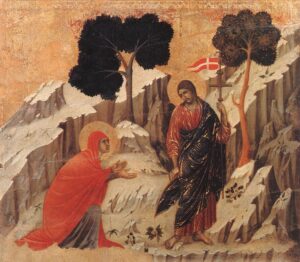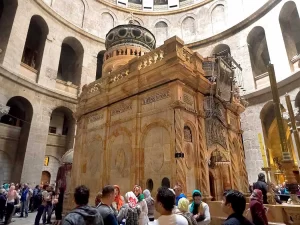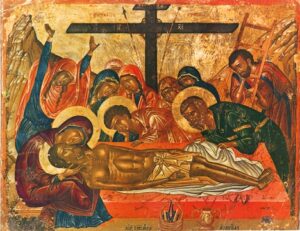Christ is risen! Truly He is risen!

He is risen!
…but I’m not. I’m still wiped out after Holy Week. This, therefore, is a re-tread of my Post #10 of April 21, 2017, written long before most of you were following this Blog.
The Resurrection Stories Which Most Orthodox Never Hear
I hate to tell you this, but most Orthodox don’t know much about Jesus’ Resurrection. Well, “Christ is risen from the dead, trampling down death by death”, of course. But for years I had the nagging feeling that something was missing about our Paschal experience in the Orthodox Church, and finally I figured out what it is: Most of the Resurrection story!
At Sunday Matins (Orthros) we hear all the Resurrection accounts on an eleven-week rotating cycle, but how many people come to Sunday Matins? The minority who attend Holy Saturday morning Divine Liturgy hear Matthew’s summary of the Resurrection story. At Liturgy on the Sunday after Pascha we hear how Doubting Thomas became Believing Thomas.
However, here’s what we Orthodox never hear at Sunday Liturgy: the stories of Christ’s Pascha morning appearance to the Myrrhbearing Women and then to Mary Magdalene alone in the garden, the Pascha night appearance in the upper room, how He walked with Luke and Cleopas on the road to Emmaus, the lovely story of the risen Lord fixing a picnic breakfast for the Apostles by the Sea of Galilee, and more.
If there was only one thing I could change in the Orthodox Church’s unchanging lectionary, this would be it.
These stories are mysterious and thrilling. What was it about the risen Lord that was so familiar, yet apparently so hard to recognize? In what way in Luke’s account was he now not “with them”, even while he was obviously still there with them?  Why did He tell Mary Magdalene not to touch him because “I am not ascended to my Father and your Father”, while Matthew says the other Myrrhbearing women clung to His feet? And then there was his ability to materialize and dematerialize which (I don’t mean to be irreverent) sounds almost like modern science fiction.
Why did He tell Mary Magdalene not to touch him because “I am not ascended to my Father and your Father”, while Matthew says the other Myrrhbearing women clung to His feet? And then there was his ability to materialize and dematerialize which (I don’t mean to be irreverent) sounds almost like modern science fiction.
There is a certain feeling that hangs over these Pascha stories: luminous, numinous, transcendent, sweet, a profound calm, an immense excitement, great joy – it’s beyond words. They have a dreamy, myth-like quality, but the point is made over and over: This was no myth, no illusion. This was Real with a capital “R”. Especially when they are read aloud – oh, I wish you would come to Sunday Matins and hear them – the Resurrection stories are wonderful in the literal sense of that word, full of wonder and awe.
As we look at these stories, I’ll try to harmonize the various accounts, insofar as this is possible, and will comment on some of the little heard, little preached-on passages that are especially interesting or puzzling, Then you should take your Bibles and search them out for yourself.
Sources: Matthew 28, Mark 16, Luke 24, John 20-21, Acts 1, I Corinthians 15
Why do we believe in the Resurrection of Christ?
Well, certainly because Jesus Christ has been alive to us. He has never been a dead hero from the past, like Buddha or Mohammed who forbade people to pray to them. From the beginning Christians have worshiped Jesus and prayed to Him as God. He has always been for us a living Lord. As Mark wrote, the Apostles undertook their mission, “the Lord working with them”.
We have “discerned Him in the Body”, as Paul put it – in His Body the Church, the Holy Community; and in his Body the Holy Eucharist we have “known Him in the breaking of the bread”. At Pascha, when out of the darkness we see the new Paschal light and hear “Come take light from the Light that is never overcome by the night; come magnify the Christ risen from the dead”, who can doubt that Jesus Christ is alive?
But all this had better be grounded in the fact that Jesus of Nazareth actually arose from death; otherwise we might just be deluding ourselves.

This is from Anglican theologian N.T Wright, interviewed in The New York Times: “It’s beyond question that when the first followers of Jesus used that language about him, they intended to say something definite about his being bodily alive, albeit in a whole new way. He seemed to have gone through death and out the other side, but into a new world in which he was emphatically embodied. Unless we are prepared to acknowledge that, we’re simply not taking their words seriously. Then, as now, claiming that somebody was alive again — particularly somebody who made the sort of claims that Jesus made or were made about him — was revolutionary. It was dangerous talk. So if people don’t like dangerous talk, then stay away from Easter is my advice.” Interviewer: Tish Harrison Warren, April 9, 2023 (used with permission)
Many years ago, a professor of theology at a now-vanished Episcopalian seminary asked his students “What would you do if they discovered the body of Jesus?” Some said, “Well, we still have His teachings.” Others “He still lives in our hearts” and so on. The professor said, “Here’s what I’d do if they found the body of Jesus: I’d go get an honest job and sell shoes or something.”
What we believe in our hearts about Jesus emerged out of the hard evidence that 2000 years ago this Man Jesus of Nazareth was executed, was stone cold dead, and then He did something unimaginable, impossible: He arose bodily from death.
An interlude to deal with the skeptics
Always there have been skeptics, disbelievers. Little wonder: everybody knows that people who die stay dead! In some Sunday Matins hymns, we actually sing the Church’s reasonable answers to the skeptics. So following their example, first let’s approach the Resurrection rationally, trying briefly to answer the various questions that have been raised over the centuries.
Skeptic: Somebody stole the body.
Christian: This theory was promoted immediately after the Resurrection. But why would anyone steal a naked soon-to-be-decaying body, leaving the grave clothes behind?

Skeptic: The Jews stole the body so Christians would not be able to claim Jesus had risen.
Christian: Then why didn’t they produce it?
Skeptic: Jesus only appeared to die.
Christian: So He was beaten up, went sixty hours without food or water, was nailed to a cross by professional executioners, hung there for hours, and was entombed. Then 36 hours later He pushed the stone away by Himself, over-powered the guards, and all day Sunday ran from place to place convincing people that He was risen? Really…?
Skeptic: The Apostles were hallucinating.
Christian: Hallucinations occur to individuals, not groups. Hallucinations make people dysfunctional. The Apostles were dysfunctional before the Resurrection. The Resurrection made them functional. When people recover from hallucinations they see them for what they were, but the Apostles always believed in the Resurrection.
Skeptic: The Apostles made it up. They stole His body and pretended He had risen.
Christian: To what purpose? All they got out of it was exile and life-long trouble. All except John were martyred for it. Obviously they were not charlatans.
Skeptic: The Resurrection accounts are not consistent in details. Were there one or two young men at the tomb? or were they angels? who saw Him first? and so on.
Christian: This is exactly what we would expect if the accounts were true. Even under ordinary circumstances different people see and remember the same events slightly differently – let alone if something unexpected and startling happens. If police investigate an accident and all the bystanders agree about every detail, they immediately suspect somebody is up to something. The Gospels are not like that. The writers obviously did not plot to coordinate the accounts. However, they agree on the fundamentals: The tomb was empty, Christ rose bodily, His bodily appearances continued for a time, then ceased.
Skeptic: Modern science has proved that miracles don’t happen.
Christian: This is not true. (The Christian who is writing this Blog was trained in science, has a degree in meteorology.) Science deals with things which happen regularly and will hold still to be measured and analyzed. Miracles do not, so science can’t speak to the subject of the Resurrection, one way or the other.
Skeptic: Modern scholarship has proved that the Resurrection story was just one more “dying and rising god” myth,
Christian: Not so. Myths took place back in the mists of time, no one knew when or (usually) where. The Gospels were written as history. For example, Luke 2, the story of the birth of Jesus: “In those days Caesar Augustus issued a decree that a census should be taken of the entire Roman world. (This was the first census that took place while Quirinius was governor of Syria.)” This was history, not myth. C.S. Lewis wrote that in Jesus Christ, “the myths became fact”.
The Story from the beginning
Holy Friday

Jesus was dead. Joseph of Arimathaea had gone to Pilate to ask for the Body and had provided his new family tomb, a cave, for his entombment. (The rocky landscape in the area did not allow burial in the ground.) It was women’s work to anoint the bodies of the dead, but the anointing had not been completed. Christ had died at 3 p.m., and at sunset the Sabbath began when Jewish Law did not permit anointing of the dead. So Christ was laid away quickly. A large stone was set over the door. Matthew says it was remembered that He had spoken of rising from the dead, so the Jewish authorities asked Pilate set a guard of soldiers, so the disciples could not steal the body and claim He was risen – though the accounts suggest the disciples were too afraid and distraught even to think of such a thing.
Pascha Morning
As soon as they could, on Sunday just before dawn, the Myrrhbearing Women went to try to complete the prescribed anointing, wondering how ever they were going to get into the tomb. Matthew says that as they arrived there was an earthquake, a radiant angel rolled the stone away and the soldiers passed out. Luke says only that the stone had been removed, and that two men in shining garments stood there. Mark mentions only “a young man in a white robe”. “Do not be afraid”, he (or they) said. “He is not here. He is risen. Come, see the place where he lay. Go tell his disciples.”
English Orthodox Chants
That and the sequence of what happened next are not quite clear – and little wonder, for the women and then the Apostles were startled, awestruck, frightened, and nobody was taking notes. The women ran back to the city to tell the Apostles. Matthew says Jesus met them on the way saying “Rejoice”, that they “worshiped” Him, clinging to his feet, and He said, “Go tell my brethren that I will see them in Galilee”. The women did so, but the disciples refused to believe them, not surprisingly. This was hard to believe. Luke says Peter then went to the tomb.
 John gives a slightly different account, obviously as recalled by Mary Magdalene. She went to the tomb first and found the stone moved away. She ran to Peter to tell him.
John gives a slightly different account, obviously as recalled by Mary Magdalene. She went to the tomb first and found the stone moved away. She ran to Peter to tell him.
Peter and John went to the tomb to see. John says he got there first, but let Peter go in first (out of fear? respect for the chief Apostle?). They found it as Mary had said. John mentions the linen shroud lying there and the head cloth neatly folded. (His Mother Mary must have taught Him right.)
Did the Apostles keep these cloths? Was one what is now called the Shroud of Turin? Another cloth now in Sovieto, Spain is claimed to be the head cloth.
Mary Magdalene must have gone back to the tomb with Peter and John. John says she then remained in the garden weeping. Through her tears she saw a man whom she assumed to be the gardener, who asked her “Why are you weeping?” She explained and begged, “Tell me where they have taken him”. The Man said to her, “Mary”. She said, “Rabboni”! (an affectionate word for “teacher”) He replied, “Do not touch me; I have not yet ascended” to the Father “but go tell my disciples…” Mary Magdalene went and told them “I have seen the Lord.”
When this story is read aloud at Matins early on Sunday morning, I always get the holy chills up and down my spine. The Church titled Mary Magdalene “Isapostalos” – Equal to the Apostles. She was first to see the Risen Lord and to proclaim His Resurrection.
The video below is from Holy Cross Church (OCA), Greensboro, North Carolina.
.
Next Week: Part Two – The Story Continues
Wonderful!
Thank you!
btw I had my biggest congregation on Holy Saturday morning – including a good number of children!
Hi Father,
There are actually 3-4 cloths that can credibly said to have been in the tomb. You mentioned the Shroud of Turin, and the Sudarium of Oveido, but the others are Veil of Manopello, and another cloth in France (I forget where at the moment). There is also possibly a cloth in Greece, but it kept secretly.
The Veil is the best candidate for the “Mandylion” / “Not made by hands” icon, as it shows the face of Christ, and is woven of a material that cannot be painted. The Veil is woven of byssus, also known as sea silk, which is a fiber only gathered in a few places in the Mediterranean from one specific type of mussel which uses strands of what is basically mother of pear to anchor itself to rocks. In ancient days this material was very expensive, and it is quite possible that Joseph of Arimethea purchased this cloth as the wrapping over Christ’s face under the burial shroud. As noted, you cannot paint it, but it (like the Shroud) bears an image that appears burned in. And it aligns with the Shroud except in one detail: in the image, Christ’s eyes are open (again aligning with the “Not made by Hands” type, unlike the Shroud of Turin).
The provenance of the cloth is old too, and it first appeared in Rome (if memory serves) in the 800s, when it was probably sent there to keep it from the iconoclasts. It vanished from Rome during the construction of the current St. Peter’s Basilica, and turned up in Manopello.
Thank you, Skip, for much information I didn’t know about.
There was a book that came out about a decade ago, called “The Face of God”, by Paul Badde, that specifically investigates the Veil. Well worth the read.
https://www.amazon.com/Face-God-Rediscovery-True-Jesus/dp/1586173383/ref=tmm_pap_swatch_0?_encoding=UTF8&qid=&sr=
Apologists tell us that early Christians were meticulous about recording the facts about Jesus’ life. If the Resurrection occurred, it was the greatest event in human history. So why didn’t any early Christian record the date of the Resurrection? The fact is NO ONE recorded the date or even the year of this earth-shattering event! Christian scholars can’t even agree on the year this event occurred.
This story is a legend, folks. If first century Jews could remember to record the date their Temple was destroyed, surely they would have recorded the date when God returned from the dead!
Sorry, but your entire worldview is based on an ancient tall tale.
Gary: Thanks for reading and writing. I note that you are a “lutheran blogger”. You don’t sound like any Lutherans I know. Tell me more!
Why didn’t the apostles give a precise date for the resurrection? I have no idea.
However, the Gospel story is clearly presented as history, set in context of the Old Testament genealogies, with Luke giving the general period for His birth and baptism. >The Gospels read like history, not like the old shadowy myths. The crucifixion took place at a Passover celebration, which would tie it down to one out of three years. (See below.) In light of the arguments with which I began this Post, I don’t see how this one matter proves the resurrection is “an ancient tall tale”. It does make me curious why they didn’t date it specifically.
Father Bill
https://cbs.mbts.edu/2020/04/08/april-3-ad-33-why-we-believe-we-can-know-the-exact-date-jesus-died/#:~:text=We%20conclude%20that%20Jesus%20was,firmly%20anchored%20in%20human%20history.
Is the date of ANY event recorded in the Bible?
Well, not in the modern sense. However, in the ancient Hebrew sense, yes: “In the year that King Uzziah died…” (Isaiah 6); “In the fifteenth year of the reign of Tiberius Caesar—when Pontius Pilate was governor of Judea, Herod tetrarch of Galilee, his brother Philip tetrarch of Iturea and Traconitis, and Lysanias tetrarch of Abilene, during the high-priesthood of Annas and Caiaphas” (Luke 3).